|
|
| home > interview |
|
Eduardo Kac. Questioning the objectivity of space Marialuisa Palumbo |
| [in italiano] | The
word space in Italian signifies an "endless and indefinite
entity", unlike the word place which signifies an "ideally
or actually delimitated area of space". But space, in its
in-definiteness, contains many other nuances like that of "margin
of action" or that of "temporal extension". Thus, the
word space assumes the form of an extremely wide territory, which has
something to do with the delimitation of places as well as with bodies
and their actions, and even with immaterial entities like temporal extension.
Etymology in fact tell us that the latin word spatium was probably
related to being open. Space is the open horizon of architecture.
This horizon is what architecture is engaged in, and even what it physically
occupies. But what are the features of our contemporary horizon? What is today's margin of action of architecture? This first interview –as the others which will come- is an attempt to think about these issues, questioning once again every presumed objectivity of space. Because today more than ever the being opened of space is revealed as to be complex, manifold, multiform, layered... From this point of view the work of Eduardo Kac -particularly his pieces more related with the conception and manipulation of space- suggest us, as human being and architects, some visionary and provocative cues to reflect about our role of masters of reality today. [MLP] A remote conversation between Marialuisa Palumbo and Euardo Kac |
[11jun2001] | ||
| Eduardo
Kac is a brazilian born artist living and working in Chicago as
Associate Professor of Art and Technology at the School of the Art Institute
of Chicago. Main feature of his experimental activity is the combination
of technologies from different research areas –as telerobotic,
networking, genetic engineering- to develop complex interactive scenarios
often enabling different spaces integration –the physical space
of one or two galleries, the virtual space of the Internet and other
more or less remote "regions" of space- as well as ways of
relationship between different life forms –humans, animals, plants.
For info about his biography, works and writings:
www.ekac.org. |
MARIALUISA
PALUMBO: Your installations strike immediately the imagination of an
architect because of their ability to be in space questioning the concept
of space itself, as well as the concept of presence in space. Every
installation is in fact the project of a circuit between at least three
different spaces: a real space (as a gallery), a virtual space (a web
site) and one or many other real spaces (an other gallery or other places
around the world connected to the first space through webcams activated
by the web site, as in Teleporting's Web Site), and every time
remote action is able to have physical consequence in real space. Using
a De Kerckhove's expression, it seems to me that your installations
could be considered as "connected architectures" that is as
systems of relations or of correlation between the different spaces
in which we happen to live, space built on the border or on the overcoming
of the border between real and virtual, multi-users universes able to
connect local and remote presences... EDUARDO KAC: It is clear that the old sender/receiver model of semio-linguistic communication is no longer enough to account for the multimodal nature of networked, collaborative, interactive telecommunication events that characterize symbolic exchange at the beginning of twenty-first century, be it in art or in the ordinary intercourse of our daily affairs. As a hybrid of robotics and telematics, telepresence adds to the complexity of this scene. In telepresence links, images and sounds are transmitted but there are no "senders" attempting to convey particular meanings to "receivers." In his essay "Signature Event Context", Derrida pointed out the multivocal nature of the word communication.  GENE(SIS). |

"ESSAY CONCERNING HUMAN UNDERSTANDING" (1994). Interspecies remote communication through telerobotic devices: an interactive scenario in-between physical and telematic space. A canary and a plant placed in two different galleries are connected through the Internet and a complex intrface system to sense the plant response to the singing of the canary and to transform it into a sound response. 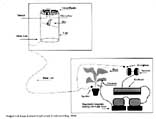 "An electrode was placed on the plant's leaf to sense its response to the singing of the bird. The voltage fluctuation of the plant was monitored through a (computer) running software called Interactive Brain-Wave analyzer.  This information was fed into another (computer)... which controlled a MIDI sequencer. The electronic sounds (sent from the plant to the bird) were pre-recorded, but the order and the duration were determined in real time by the plant's response to the singing of the bird". [E. Kac] |
||
 "RARA AVIS" (1996) A VR headset enable the visitor to see through the eyes of an electronic macaw. As the viewer moves the head the same movement takes place with the macaw's head causing a change of viewpoint.  "in our day life we take it for granted that we live in a single, real world, with a single body and consciousness – but is our condition really that secure?" [M. Kusahara] 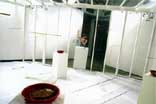 "With the advent of the Internet, living virtually in another community (or another space) is becoming an ordinary aspect of life. Having another ‘self' in another world as an avatar is also possible. But then where do we live... 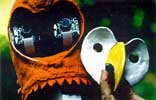 Do we belong to different spaces at the same time in a loop of switching realities?" [M. Kusahara] |
"We
also speak of different or remote places communicating with each other
by means of a passage or opening. What takes place, in this sense, what
is transmitted, communicated, does not involve phenomena of meaning
or signification. In such cases we are dealing neither with a semantic
or conceptual content, nor with a semiotic operation, and even less
with a linguistic exchange." It is this opening, this passage between
two spaces, which defines the nature of the particular communication
experience created by telepresence art. This opening is not a context
for "self-expression" (of the author or of the participant);
it is not the channel for communicating semiologically defined messages;
it is not a pictorial space where aesthetic formal issues are structurally
relevant; it is not an event of which one can clearly extract specific
meanings. My telepresence works employ telerobots designed and built specifically for each project. Through the telerobot the participant gathers images, hears the remote sounds, and/or affects changes in the distant environment. The shortest distance between two points is no longer a straight line, as it was in the age of the locomotive and the telegraph. Today, in the age of satellites and fiberoptics, the shortest distance between two points is real time. The ability to commute information instantaneously, to send and receive sound and images immediately ("i-mmediately, or with no apparent medium or means?"), accounts for the decreasing social relevance of the extensity of space in regard to the intensity of time.  GENE(SIS). |
|||
| MARIALUISA
PALUMBO: From the point of view of the construction of space, an
other surprising element concern, in fact, the "position"
of the user: visiting one of your installations it is not simply like
going through a space in the traditional way, but it is more like exploring
a device which dislocate, overturn, or simply push further the borders
of the traditional experience of space. For exempla, in Rara Avis the
visitor has to face a double point of view: external to the cage and
turned to it, and internal to the cage and turned to the visitor. In
Darker than Night the user has instead to explore the space through
a kind of echolocation system exchanging signals with other real bats.
In other words, these installations seem to invite us to think about
how the experience of the body in "real" space can be extremely
expanded through electronic technologies... |
"TELEPORTING
AN UNKNOWN STATE" (1998) To survive plants need photons, the smallest part of energy in electromagnetic waves. In this installation, viewers in the gallery saw a plant sprouting from the center of a rectangular field on the floor and growing through a "teleportation of photons" through the video projector.  Remote participants were invited to activate a network of webcams directed at the sky of eight regions of the Earth: the Website – with the images collected by the webcams- was projected on the soil floor of the gallery giving light to the plant. 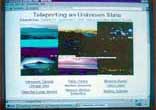 Through the network infrastructure, the physical space of the gallery, the life in it and remote places around the world were connected.  Remote action enabled physical consequence in real space in real time.
|
|||
| "DARKER
THAN NIGHT" (1999) Through a robotic bat (batbot) and a virtual reality headset, the viewer's sight is transformed into the point of view of the batbot's sonar. 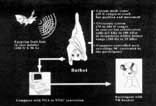 The biosonar echolocation system of the bat is converted to audible waves accessible to the human sensory system and in a series of real-time kinetic white dots against a black background. The white dots represent obstacles encountered by the batbot's sonar.  "Darker Than Night is a network of relationships, a complex circuit of signals that circulate between human (visitor with headset), animal (bat emitting and hearing ultrasounds as their "sense of vision"), and machine (batbot that simulates the real bats while echolocating in the same manner as them)". [S. Milevska]  |
EDUARDO
KAC: By asking humans to temporarily take the
point of view of another life form, my goal is to point out that there
are as
many realities as there are sensorial systems to aprehend them, and
intersubjective experiences to construct them. My work integrates cognitive
ethology, consciousness studies, cybernetics, and dialogical philosophy,
as in the work of Uexküll, Griffin, Nagel, Maturana, Bakhtin, and Buber.
I'm in agreement with Abraham A. Moles, who wrote: "As we enter
the age of telepresence we seek to establish an equivalence between
‘actual presence' and ‘vicarial presence'. This vicarial presence
is destroying the organizing principle upon which our society has, until
now, been constructed. We have called this principle the law of proximity:
what is close is more important, true, or concrete than what is far
away, smaller, and more difficult to access (all other factors being
equal). We are aspiring, henceforth, to a way of life in which the distance
between us and objects is becoming irrelevant to our realm of consciousness.
In this respect, telepresence also signifies a feeling of equidistance
of everyone from everyone else, and from each of us to any world event”. MARIALUISA PALUMBO: Let's reflect for a moment about the "machine", that is about the technology or the tools which make it possible to your installations to be "circuits", from the loop of Essay Concerning Human Understanding, to the interactivity between different spaces (real, virtual, actual, remote) and different life forms (human, animal, vegetal) of all other installations. It seems that the machine, from being an instrument of alterity and alienation, it has now become a networking system: even more than a classic instrument of communication, a system to relate different kind of things, in other words a system to overturn not any more a physical distance but to overturn the "difference" itself, not only between here and elsewhere but also between subject and objects...  GENE(SIS). |
|||
|
EDUARDO KAC: Networking is both a technical means of linking
disperse entities and an intellectual tool to perceive the ultimate
connectivity between all there is. In my work I have pursued both meanings
of "networking". My point is not to eliminate "difference",
which is impossible, but to create more complex ways to examine the
interplay between similarity and difference. In other words, to allow
us to see that inspite of difference, the similarities are much stronger
than we once thought. Telerobotics and molecular biology are some of
the tools I have enlisted to this end. Consider Maurice Marleau-Ponty,
for whom our not-sameness to each other is not a flaw, but is the very
condition of communication. He wrote: "the body of the other -as
bearer of symbolic behaviors and of the behavior of true reality- tears
itself away from being one of my phenomena, offers me the task of a
true communication, and confers on my objects the new dimension of intersubjective
being." For Marleau-Ponty it is in the ambiguity of intersubjectivity
that our perception "wakes up". |
"UIRAPURU"
(1999) A radio controlled blimp 'fish' floats above a tropical forest of fake vegetation. The gallery physical world is simulated in a VRML world in flat screens at the rim of the artificial forest.  The real/artificial forest is a layered interface between the physical world and the virtual one: visitors experience interactivity both in real and virtual space on the Net.  Experience oscillates between actual and remote action, real presence and real time telepresence. 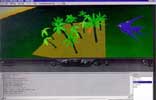 |
|||
| GENE(SIS)
(1999) "Let man have domain over the fish of the sea and over the flow of the air and over every living thing moves upon the earth". [Bible, Genesis] 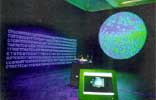 A microvideocamera projects the large circular image of bacteria in a petri dish. Each bacteria is written in the same genetic language as our bodies, but here some of them carry a gene that does not exist in nature, a synthetic gene crafted by the artist encoding a passage from the Bible and combined with a protein that glows cyan when illuminated by ultraviolet light.  To translate our natural language into the language of cell, the AGCTs of the DNA, Kac used the Morse code: after translating the biblical passage into the dots and dashes of the Morse Code, the dots were replaced by the genetic base Cytosin (C); dashes were substituted with Thymine (T); word spaces replaced by Adenine (A), while letter spaces by Guanine (G). This unique string of AGCTs constitutes a new gene.  The gene mutates live through the Internet as Web viewers/participants activate a source of ultraviolet light in the gallery, thus changing the original meaning of the text. The gallery space is thus transformed into a polyglot triptych where the same passage is presented in three languages: the alphabetic one, the biological one and the technological morse/digital one. |
MARIALUISA
PALUMBO: From my point of view, your installations look like perfect
metaphors of the emergent sign which characterize our epoch compared
to all the previous: the emergence of a new space-time dimension where
organic and non organic elements experience a new continuity, stronger
and more powerful than the simple physical continuity, a new condition
of "webness" rooted first of all in our control over the deep
codes of life and language. In Genesis for example the alphabetic code,
the biological one and the digital one, experience a kind of symbolic
convergence... EDUARDO KAC: In the Nineteenth Century the comparison made by Champollion based on the three languages of the Rosetta Stone (Greek, demotic script, hierogliphs) was the key to understanding the past. Today the triple system of Genesis (natural language, DNA code, binary logic) is the key to understanding the future. "Genesis" explores the notion that biological processes are now writterly and programmable, as well as capable of storing and processing data in ways not unlike digital computers. Further investigating this notion, at the end of the show the altered biblical sentence is decoded and read back in plain English, offering insights into the process of transgenic interbacterial communication. The boundaries between carbon-based life and digital data are becoming as fragile as a cell membrane. MARIALUISA PALUMBO: I'd like to ask you just a last question, where I'd like to shift the focus from the objects or objectives of your research to the creative process itself: can you tell me something about the process through which you develop a piece? EDUARDO KAC: All my works have in common the sets of issues that preoccupy me, which revolve around questions of communication - communication not as transmission of information but as a living process. Since I have no regard for the anachronistic notion of "style", each work evolves its own material and networking solution. I'm equally concerned with the aesthetic and the social aspects of verbal and non-verbal interaction: linguistic systems, dialogic exchanges, and interspecies communication. Once I have identified the strategies I need to pursue in order to convert an idea into an artwork, I then seek the means to implement the project. This is often a lengthy process, involving research, dialogue, and interdisciplinary effort. The work is often produced in the same distributed manner it is experienced, with coordinated efforts in multiple cities simultaneously.  Alba, the fluorescent bunny. Photo: Chrystelle Fontaine. |
|||
| > EDUARDO KAC | ||||